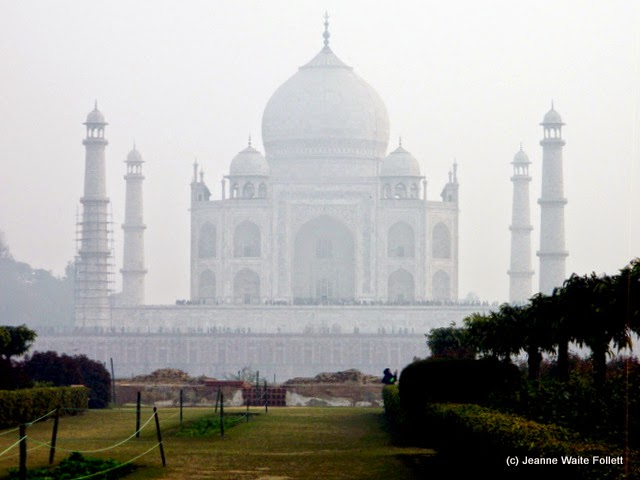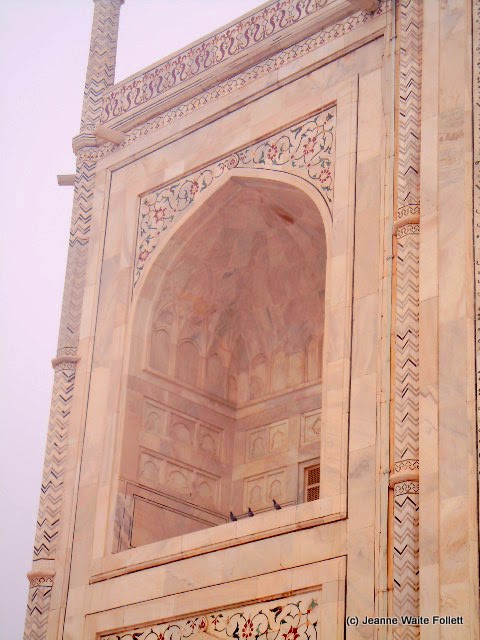Ch. 24, Taj Mahal: The Myth and the Mist
For some we loved, the
loveliest and the best
That from his Vintage
rolling Time hath prest,
Have drunk their Cup a
Round or two before,
And one by one crept
silently to rest.
—Omar Khayyam, The
Rubaiyat
Dense pewter-colored fog hovers over Agra
this early morning as we set out to be among the two million and more who visit
the Taj Mahal every year. We are hoping the fog will lift when we reach
the most famous mausoleum in the world.
Our coach moves swiftly through the
streets of the awakening city and soon pulls over to the curb to let us
off. Men are hovering over small fires
in braziers or simply built on the ground.
We cross a street to the parking lot and the hawkers descend immediately.
 |
| This warming by a small fire seems to be the primary occupation of men everywhere in India. |
An electric bus will take us to the
first gate of the Taj because vehicles that pollute are not allowed within a
certain distance of the complex. The
hawkers find me immediately and hinder my progress to the bus. One
holds up a book on the Taj and says, “Remember me. I’m Sam.
Remember.”
“Dave. I am Dave.
I will see you when you come out,”
another says as he holds up a cellophane packet with a dozen tiny
elephants in it in front of my face.
Even after I'm on the bus, they find me and yell
at me through the window. Finally the
bus moves away from them. The fog
remains thick as we pass through the red sandstone ticket entrance gate and
security, where our bags are placed on a conveyor belt for scanning.
 |
| The first gate and the entrance queue. |
Inside are one story buildings where the
artisans who carved the marble for the Taj Mahal lived while they worked and
afterwards, the many attendants who worked at the completed building.
We walk through gardens to another
massive red gate and pass through it, hoping to see the famous icon of India.
Ah, the Taj Mahal. Its very name evokes the memory of a love so
enduring that a strong emperor was brought to his knees when his lovely wife
died while giving birth to their 14th child, and he went into
seclusion for six months. Only after a
seed of an idea was planted in his brain did he find purpose in living again.
And thus was created the Taj Mahal, a mausoleum
so magnificent that people from around the world would come to see it in all
its glory, and women everywhere would sigh and dream of a love so sublime. Its very image is the icon of the rich and
glorious part of India.
Or so the many guides and guide books
tell us. Today, the Taj Mahal is hidden
in mist, a beautiful seductress behind her veil.
A long rectangular reflecting pool
stretches into the infinity of the fog. Today, it reflects the gray mist that
masks everything. On either side are Persian gardens designed
with Islamic symbolism.
We continue through the gardens until we
reach a set of benches, where we sit and don thin cloth booties over our
shoes. The Taj is not a temple and
shoes do not need to be removed. The booties
are meant to protect the white marble from the wear of millions of footsteps.
 |
| Right after I took this photo, he stood up, waggled his booted foot at me and said, "I'm shaking my booty for you." |
 |
| Residents of India pay a MUCH smaller admission fee than tourists. |
 |
| Even the steps up to the plinth are covered to prevent wear. |
The Taj reveals itself slowly in the
mist and, despite its mass, appears to be floating above its platform, called
the plinth. A thousand elephants and
untold teams of oxen hauled blocks of marble more than 200 miles to this
site. Some blocks are said to have weighed six
tons each. The entire structure is
thought to weigh 2.5 thousand trillion kilos.
Once on the plinth, 23 feet above the
surrounding gardens, the mausoleum itself dwarfs everything in the area. The mist exaggerates the size of the height
of the main dome that reaches 115 feet.
Each side of the main building is 180 feet long, rich with arches and
exquisite inlaid calligraphy and precious stones.
 |
| All of these are inlaid. |
 |
| Note the Islamic calligraphy inlaid into the marble. |
On each corner of the plinth are
minarets built so they lean slightly outward, a safety measure that ensures a
falling one would not damage the mausoleum itself. The minarets are 130 feet high.
Inside the main dome, where no photos
are allowed, lie two false crypts and they are the only non-symmetrical
elements here, as the Shah’s crypt is by tradition larger than his wife’s. They are surrounded by an octagonal screen of
eight panels carved from white marble and decorated in delicate detail. The actual crypts of Shah Jahan and his wife,
Mumtaz, are under this floor.
On either side of the Taj are two
identical buildings, one a mosque and the other perhaps a guest house. There can be only one mosque and since the
second does not face Mecca, it cannot be a mosque. It was built for symmetry.
 |
| One of two identical side buildings, one of which is a mosque. |
As shrouded in myth as it is in mist, no
one knows for certain which story is true and which is not. It is generally agreed that Mumtaz was the 3rd and favorite
wife of Shah Jahan, who ruled what is now northern India, Pakistan, and
Afghanistan from 1628 to 1658. Some
sources say Mumtaz died during birth of their 14th child, others say
7th child. Still others say
only 7 of the 14 survived to adulthood.
Was it the love story of the ages? Or was it the result of the overly romantic
story-writing fashionable in that era?
The Taj construction took 22 years, and
soon after its completion, Shah Jahan was deposed by his son, or he fell ill
and was confined to nearby Agra Fort by his son, who became emperor, or both. Take your pick.
The deposed shah could see the lovely
Taj Mahal from his cell at Agra Fort, claim some. Others refute that, claiming there are no official
documents supporting it.
On the far side of the Taj is the Yamuna
River. According to legend, Shah Jahan
intended to build an identical replica of the Taj, but in black marble. Again, this is disputed by many and thought
to have originated in the writings of a foreign visitor. The ruins of a “foundation” are thought to
be the ruins of the octagonal pool in the Midnight Gardens.
 |
| In the Midnight Gardens across the river. Foundation for a black marble Taj or a reflecting pool? |
 |
| The same site. |
One story says the Shah’s son spent much
of the money set aside to build the black marble Taj.
Some claim Shah Jahan ordered the workers’
hands be chopped off so they could not recreate another Taj. If so, who would build the black marble Taj
across the river?
And still others claim the Taj Mahal,
with all its Persian influence, was actually built by Hindus. Not even India’s Supreme Court would buy that
one and it dismissed a lawsuit that hope to declare the Taj a Hindu creation.
The fog never lifts on this magnificent
complex today. On a visit to the gardens
on the far side of the river at sunset, the Taj is still shrouded in mist and
mystery, her secrets intact through the ages.
MORE PHOTOS OF THE TAJ MAHAL. I have adjusted the lighting in some of them to make them clearer. At the bottom of my photos are some by a professional photographer who photo-shopped us into clear photos.
 |
| The marble surface of the plinth. |
 |
| Dinesh explaining things. |
 |
| This is one photo where I have adjusted the lighting. The structure is not this dark. |























































